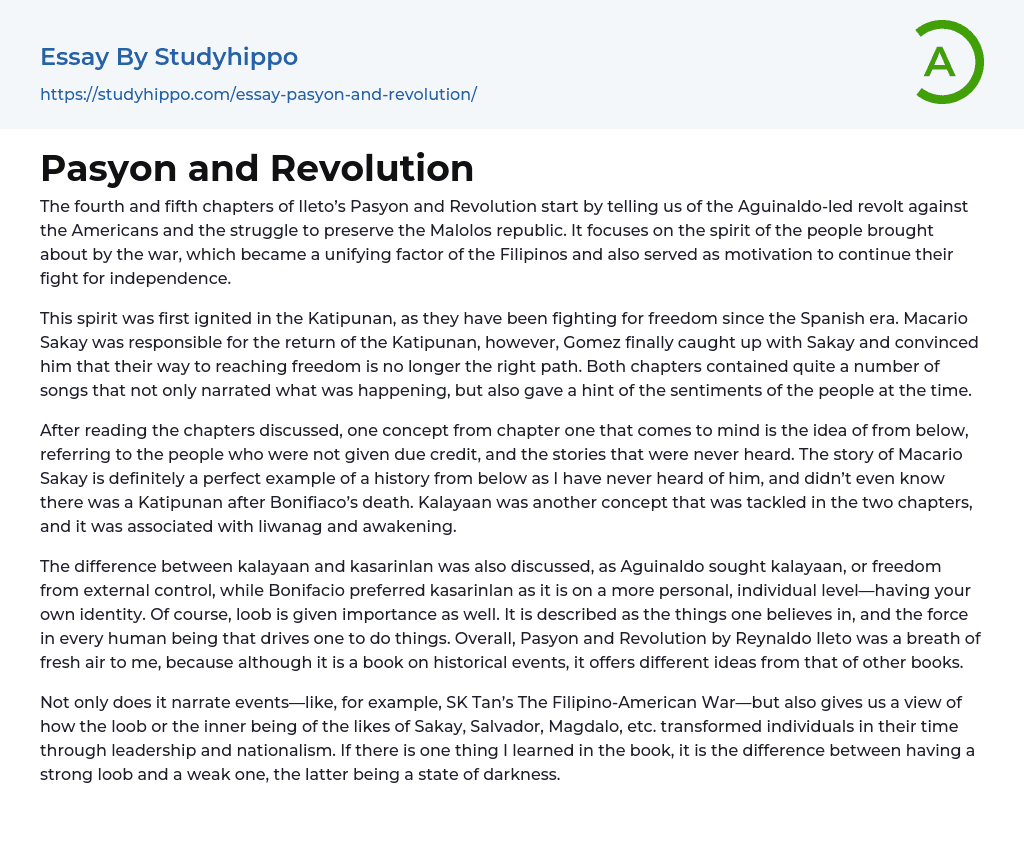The fourth and fifth chapters of Ileto’s Pasyon and Revolution start by telling us of the Aguinaldo-led revolt against the Americans and the struggle to preserve the Malolos republic. It focuses on the spirit of the people brought about by the war, which became a unifying factor of the Filipinos and also served as motivation to continue their fight for independence.
This spirit was first ignited in the Katipunan, as they have been fighting for freedom since the Spanish era. Macario Sakay was responsible for the return of the Katipunan, however, Gomez finally caught up with Sakay and convinced him that their way to reaching freedom is no longer the right path. Both chapters contained quite a number of songs that not only narrated what was happening, but also gave a hint of the sentiments of the people at the time. ...
p>
After reading the chapters discussed, one concept from chapter one that comes to mind is the idea of from below, referring to the people who were not given due credit, and the stories that were never heard. The story of Macario Sakay is definitely a perfect example of a history from below as I have never heard of him, and didn’t even know there was a Katipunan after Bonifiaco’s death. Kalayaan was another concept that was tackled in the two chapters, and it was associated with liwanag and awakening.
The difference between kalayaan and kasarinlan was also discussed, as Aguinaldo sought kalayaan, or freedom from external control, while Bonifacio preferred kasarinlan as it is on a more personal, individual level—having your own identity. Of course, loob is given importance as well. It is described as the thing
one believes in, and the force in every human being that drives one to do things. Overall, Pasyon and Revolution by Reynaldo Ileto was a breath of fresh air to me, because although it is a book on historical events, it offers different ideas from that of other books.
Not only does it narrate events—like, for example, SK Tan’s The Filipino-American War—but also gives us a view of how the loob or the inner being of the likes of Sakay, Salvador, Magdalo, etc. transformed individuals in their time through leadership and nationalism. If there is one thing I learned in the book, it is the difference between having a strong loob and a weak one, the latter being a state of darkness.
- Barangay essays
- American Civil War essays
- Atomic Bomb essays
- Attack essays
- Cold War essays
- Crimean War essays
- Diplomacy essays
- Emilio Aguinaldo essays
- Emperor essays
- Hitler essays
- Iraq War essays
- Korean War essays
- Mexican American War essays
- Nazism essays
- Nuclear Weapon essays
- Philippine Revolution essays
- Revolutionary War essays
- Rwanda essays
- The Spanish American War essays
- Trench Warfare essays
- Tribe essays
- Vietnam War essays
- War of 1812 essays
- Western Front essays
- World War I essays
- World War Ii essays
- Bangladesh essays
- China essays
- Hong Kong essays
- India essays
- Japan essays
- Kuala Lumpur essays
- Malaysia essays
- Manila essays
- Pakistan essays
- Philippines essays
- Singapore essays
- Vietnam essays
- Vietnamese essays
- 1920S essays
- 1950S essays
- 1960S essays
- 19Th Century essays
- 20Th Century essays
- Ancient Greece essays
- Bravery essays
- British Empire essays
- Civilization essays
- Colonialism essays
- Declaration of Independence essays




